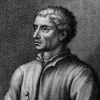Leon Battista Alberti

Leon Battista Alberti
Leon Battista Albertiwas an Italian humanist author, artist, architect, poet, priest, linguist, philosopher and cryptographer; he epitomised the Renaissance Man. Although he is often characterized as an "architect" exclusively, as James Beck has observed, "to single out one of Leon Battista's 'fields' over others as somehow functionally independent and self-sufficient is of no help at all to any effort to characterize Alberti's extensive explorations in the fine arts." Alberti's life was described in Giorgio Vasari's Lives of the Most Excellent...
NationalityItalian
ProfessionArchitect
Date of Birth14 February 1404
CountryItaly
I shall praise those faces which seem to project out of the picture as though they were sculptured, and I shall censure those faces in which I see no art but that of outline.
Perhaps the artist who seeks dignity above all in his 'historia', ought to represent very few figures; for as paucity of words imparts majesty to a prince, provided histhoughts and orders are understood, so the presence of only the strictly necessary numbers of bodies confers dignity on a picture.
What is painting but the act of embracing, by means of art, the surface of the pool?
The greatest work of an artist is the history of a painting.
There is no art which has not had its beginnings in things full of errors. Nothing is at the same time both new and perfect.
The Arts are learnt by reason and method; they are mastered by practice.
I would have artists be convinced that the supreme skill and art in painting consists in knowing how to use black and white... because it is light and shade that make objects appear in relief.
No art, however minor, demands less than total dedication if you want to excel in it.
Men can do all things if they will.
A man can do all things if he but wills them.
Beauty: the adjustment of all parts proportionately so that one cannot add or subtract or change without impairing the harmony of the whole.
Nothing overshadows truth so much as authority.
I prefer you to take as your model a mediocre sculpture rather than an excellent painting, for from painted objects we train our hand only to make a likeness, whereas from sculptures we learn to represent both likeness and correct incidence of light.
Practice by drawing things large, as if equal in representation and reality. In small drawings every large weakness is easily hidden; in the large, the smallest weakness is easily seen.